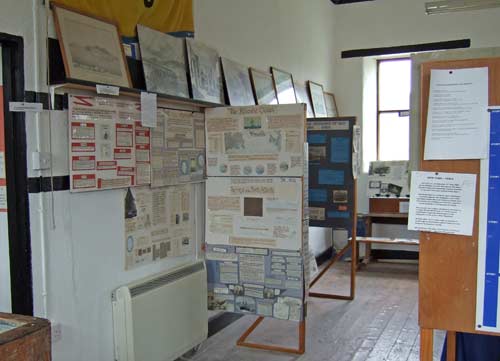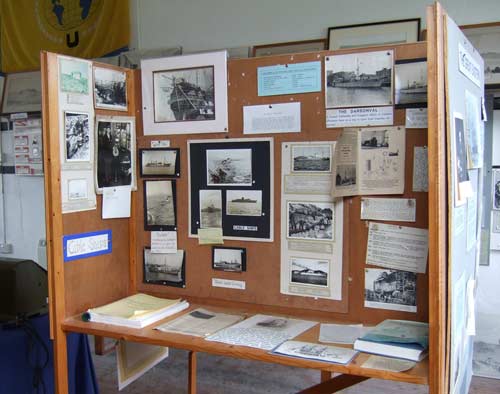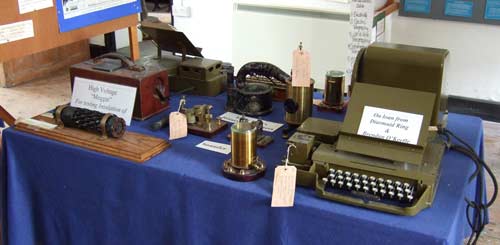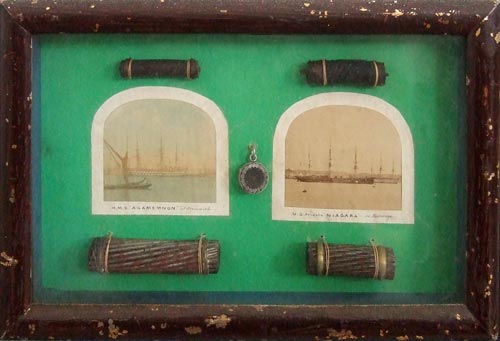Exhibits
The Centre has three main display rooms, each with its own theme: the School-Room; Island and Harbour; and the Transatlantic Telegraph Cable .
The School-Room
The noted naturalist Maude Jane Delap lived and worked in Knightstown, carrying out important research into the marine life surrounding Valentia and identifying many new species. On display in this room are examples of flora and fauna to be found on Valentia and its environs, as well as information on the abundant sea life that surrounds Valentia.
When life was evolving from water onto land, a salamander-like creature left his (or her?) footprints in the sand on an ancient Valentia beach. In 1992, some 385 million years later, these fossilised prints were discovered by a visiting geology student, Mr. Iwan Stoessel.
A cast of the footprints, and other information on this important paleontological find, may be seen in this room. Iwan Stoessel notes: "Trackways of Devonian tetrapods are very rare, but provide valuable insights into the earliest phase of the conquest of the land by vertebrates."

General view of the School Room |
This room also has displays on the Knights of Kerry, who lived in Glanleam House on the island. They owned land, which was used by the people of the island who could afford to pay the rent. Glanleam House still stands today, and is now a Bed & Breakfast, while its grounds are a sub-tropical garden.

Another view of the School Room |
Island and Harbour
'Oilean Dairbhre' (Island of the Oaks), the original name, was supplanted by that of the harbour, a haven to seafarers on a wild rugged coast marked on the earliest maps of Europe. Valentia heralds Europe's weather; the first telegraph weather report being sent to London in 1862. And in 1867, Valentia Observatory was set up to record and pass on vital meteorological and geodetic data.
From 1825, Valentia slate slabs were shipped to England for the construction of many public buildings - including the House of Commons and the National Gallery.
The sea has played a profound role in the lives of Islanders for the earliest times. Fishing and angling are still important local industries. Over the years they have manned the Lighthouses and the Lifeboats, dealt with Pirates and Traders, Manxmen and Spaniards, Cromwellian soldiers and pioneering aviators.
The Transatlantic Telegraph Cable
Valentia Island was the base of the very first attempts at laying the Atlantic cable in 1857 and 1858, and of the successful expedition of 1866, and is the location of the oldest Atlantic cable stations in the world. The 1857 and 1858 cables were laid from Ballycarbery at Valentia Harbour, while the 1865 and 1866 cables originated at Foilhummerum Bay.
When Western Union closed its cable stations 100 years later (in 1966), much of the contents of the Valentia station was allowed to be sold off or discarded. But now, cable information and instruments are being collected, so the story of Valentia's role in that great achievement may be told again. There are stories within stories, the drama of the cable laying expeditions, the impact on commerce and politics, the involvement of scientists and engineers who would later become household names.
Here are some views of the cable history room at the Heritage Centre:
 |
 |

Cable and telegraph equipment on display |

A souvenir of the 1858 cable - framed sections
of
the cable,
with photographs of the two main ships
of
the cable fleet,
the Niagara and Agamemnon |
For many more photographs and further details of the cable displays,
see the Atlantic Cable website. |